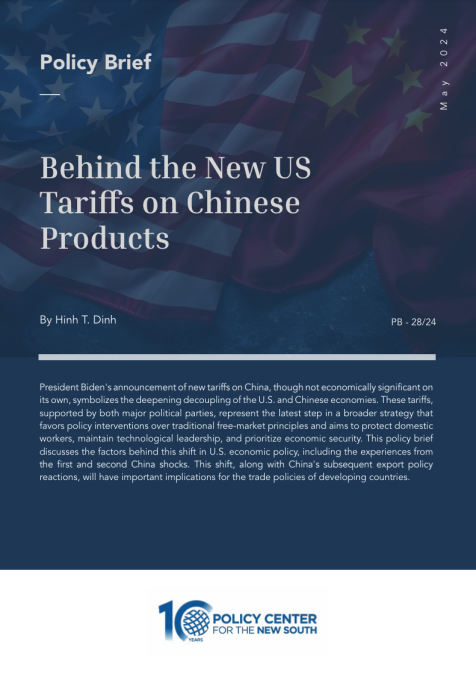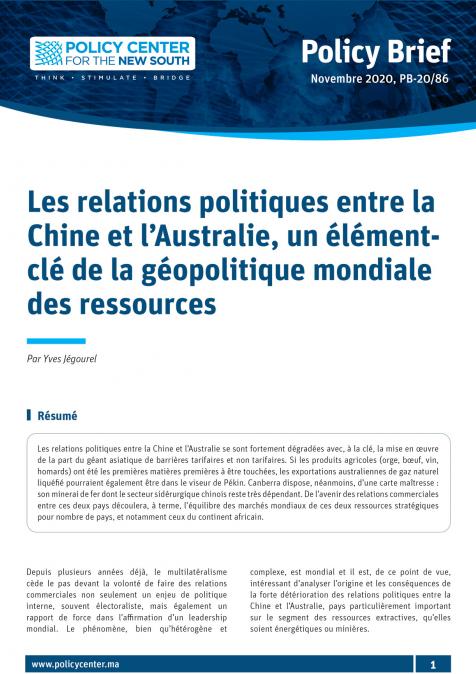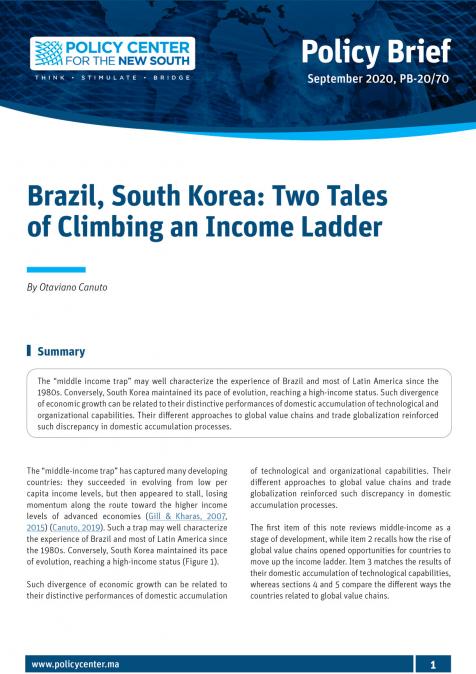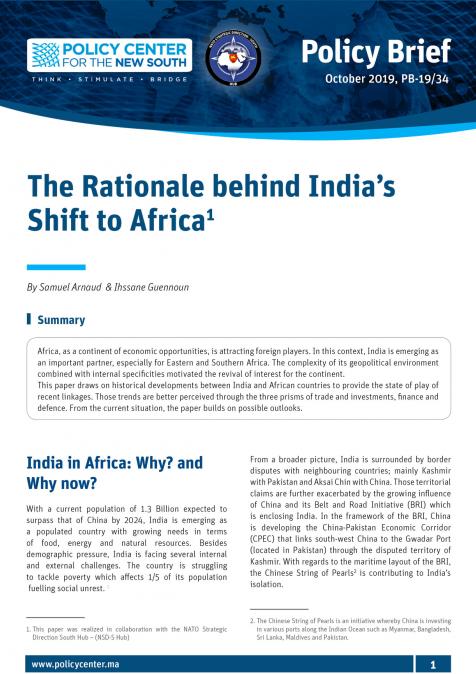Publications /
Policy Brief
President Biden's announcement of new tariffs on China, though not economically significant on its own, symbolizes the deepening decoupling of the U.S. and Chinese economies. These tariffs, supported by both major political parties, represent the latest step in a broader strategy that favors policy interventions over traditional free-market principles and aims to protect domestic workers, maintain technological leadership, and prioritize economic security. This policy brief discusses the factors behind this shift in U.S. economic policy, including the experiences from the first and second China shocks. This shift, along with China's subsequent export policy reactions, will have important implications for the trade policies of developing countries.
On May 14, U.S. President Joe Biden announced major tariff increases on a variety of Chinese imports, including electric vehicles (EVs), semiconductors, and medical products. Although the amount of current U.S. imports affected by these tariffs is small—$18 billion in the context of total 2023 Chinese imports of $427 billion—the new tariff increases have significant implications for U.S. trade strategy. These measures are conceived more as preventive rather than curative trade corrections, and could signal the beginning of a tense trade war that goes beyond mere protectionism. This article first discusses the scope of these tariff increases and their impact on the U.S. and China, followed by an in-depth discussion of the reasons behind such protectionism.
Scope of Tariff Increases
The recent increase in U.S. tariffs on Chinese imports involves significant changes aimed at countering China’s trade practices. The tariffs target a range of strategic sectors, including steel and aluminum, semiconductors, electric vehicles (EVs), and critical minerals.
Steel and Aluminum: Tariffs on certain steel and aluminum products have been increased from 7.5% to 25%. According to the White House, this move aims to protect the U.S. steel industry from Chinese overcapacity and unfair subsidies, which has resulted in artificially low-priced, high-emissions products that compete with U.S. goods.
Semiconductors: Tariffs on semiconductors will rise to 50% by 2025. The rationale is to mitigate the risks posed by China’s expansion in semiconductor manufacturing, which threatens market-driven investments and exacerbates supply-chain vulnerabilities. The U.S. CHIPS and Science Act, providing nearly $53 billion for domestic semiconductor manufacturing, complements this tariff increase.
Electric Vehicles (EVs): The tariff on electric vehicles will jump to 100% in 2024. The Biden Administration’s broader strategy includes tax incentives for domestic EV and battery production, consumer credits, and infrastructure investments.
Batteries and Critical Minerals: Tariffs on lithium-ion EV batteries and other critical minerals will increase to 25%, with some items, including natural graphite and permanent magnets, facing the same rate by 2026. This measure is designed to reduce US dependency on China for critical components in the clean-energy supply chain, and to enhance domestic production capabilities.
Other Products: The tariff on ship-to-shore cranes will rise to 25% from zero; tariffs on syringes and needles will rise to 50% from zero now, and some personal protective equipment (PPE) used in medical facilities will rise to 25% from as little as 0% now. These tariffs aim to encourage domestic manufacturing and reduce reliance on Chinese imports in these essential sectors.
According to the White House, these tariff increases are part of a broader effort to address China’s unfair trade practices and support US industries. The administration has also directed measures to prevent tariff evasion and strengthen enforcement against anti-competitive practices. These actions reflect a strategic approach to bolster domestic manufacturing, protect jobs, and ensure fairness.
Economic Impact
Impact on the US: In the short term, the tariff hikes will have limited impact on U.S. consumer prices and economic growth, mainly because current imports of big items such as EVs from China are virtually zero. The $18 billion worth of imports consists mostly of lithium-ion batteries ($13 billion), with some steel and aluminum products and medical supplies accounting for the rest. In the long run, the increased tariffs may encourage American companies to diversify their supply chains and reduce dependence on Chinese imports. This could lead to the development of new trade partnerships and the growth of domestic industries. However, such shifts take time and investment, and the transition period could be economically challenging.
Impact on China: As of this writing, China has not retaliated. The short-term impact is declining orders and profit margins for producers of affected goods for the U.S. market. China may seek to strengthen trade relationships with other countries, particularly in Southeast Asia, Africa, and Europe, to mitigate the impact of reduced access to the U.S. market. In the long term, China may accelerate its efforts to shift its economic model from export-oriented growth to one driven by domestic consumption and innovation. This transition would align with China's current economic goals, but could be hastened by the pressures of the trade conflict.
Impact on Global Trade: The increase in US tariffs on Chinese imports has significant implications for global trade. Increased tariffs contribute to an environment of uncertainty, which can dampen global economic growth. Countries that are part of the supply chains for U.S. and Chinese goods may experience disruption, leading to broader economic instability. Furthermore, the trade conflict may encourage other countries to adopt more protectionist policies, leading to greater fragmentation of the global trading system. This could undermine institutions such as the World Trade Organization (WTO), which are designed to promote free and fair trade. On the other hand, some countries may see opportunities to fill the gaps left by reduced U.S.-China trade, potentially leading to a reconfiguration of global trade networks.
The increase in tariffs is not merely an economic measure; it also has significant political and strategic aspects. For the United States, the tariffs are part of a broader strategy to address concerns about China’s trade practices, including intellectual property theft, forced technology transfers, and state subsidies for Chinese companies. By increasing tariffs, the U.S. aims to pressure China into making structural reforms that would create a more level playing field for American businesses.
It is clear that the trade war will continue no matter who wins the U.S. Presidential election in November 2024. Protectionism is now the consensus economic policy of both major political parties in the United States. Biden has extended the Trump tariffs on China and levied the new EV tariffs; Trump is trying to outdo Biden by promising to raise the 100% tariffs to 200%, extend them to Mexico, and slap an additional 60% tariff on all Chinese- made goods. There is currently no major party or policymaker in the U.S. that is even remotely interested in free trade. To understand the reason for this shift from free trade to protectionism requires some deeper analysis of the U.S. economy in the last twenty years.
The First and Second China Shocks
All economists learn and embrace the merits of free trade in their first international economics lesson. Only in 2016, and very reluctantly, were they forced to abandon this ideal concept when three economists, among them MIT economics professor David Autor, published a paper1 showing that trade with China devastated a large part of the American workforce in the 2000s—the so-called decade of the first China shock. Autor et al (2016) showed that in response to Chinese imports, the adjustment in the US local labor market was very slow, with the local unemployment rate remaining elevated for at least a decade after the initiation of the China trade shock. Nationally, the employment declines in sectors exposed to imports were not counterbalanced by gains in other industries. Accounting for both direct and indirect costs, it is estimated that the US lost approximately one million manufacturing jobs and 2 million jobs across the economy. These job losses and their contribution to the subsequent hollowing out of the US economy were discussed in a book written by this author and published by the Policy Center for the New South in 20172. The competition with China was so intense and widespread across all sectors that it eroded the well-paying factory jobs that had historically formed the backbone of the American middle class. Consequently, many US factory workers had to transition into lower-paying service- sector jobs. Some ended up relying on welfare assistance.
The second China shock refers to the current period (2020s) when, since COVID-19, the Chinese economy is in a weak position, with the real estate market in collapse causing problems for banks and local governments. To fuel growth, China has decided to produce more manufacturing where its large domestic market gives it a competitive edge. To do this, the government encourages banks to lend to manufacturing companies instead of to real estate or local governments. Furthermore, the central government subsidizes the manufacturing sector, particularly in priority sectors including semiconductors, electric vehicles, batteries, solar panels, steel, and aerospace. In a study for the Center for Strategic and International Studies, Dipippo et al (2022)3 estimated that in 2019, China spent over $210 billion at market exchange rates ($348 billion in PPP) in industrial policy spending, compared to $84 billion of spending by the U.S. and $26 billion by Japan. Since COVID-19, the wide range of subsidies—both direct subsidies such as cheap government directed bank loans, and indirect subsidies such as weak environmental regulations—have made Chinese products even more competitive.
To match up this increased supply, China must raise investment, consumption, or exports. However, investment already reached 43% of GDP in 2023, while domestic consumption has been constrained by slow economic growth, economic uncertainty, and a high unemployment rate, especially among young people. The decision to focus on manufacturing rather than services (such as health, education, and social services) also supports exports as an engine of growth, as these products are often intended for foreign markets. In previous situations involving strong manufacturing exporters such as Japan, Germany, or Korea, concern about economic efficiency caused these countries to reduce output if there were signs of oversupply. But China’s supply is on such a large scale that concerns about keeping Chinese workers employed and building strategic industries lead its goods to flood the market, potentially destroying domestic industries in the EU, the U.S., and even developing countries.
In the U.S., the beneficiaries of the first China shock were the multinationals, high-tech industries, retailers, consumers, and bankers. The political weight of these groups combined was much greater than that of the workers who suffered from the Chinese imports. This explains why protection did not increase during this period. In contrast, the beneficiaries of the second China shock no longer include the multinationals, as China has been able to develop its own enterprises—BYD replacing Tesla, and Huawei replacing Apple. In fact, some U.S. multinationals are trying to get out of China. Similarly, high-tech industries can no longer benefit from selling their products in China because Chinese companies have completed their supply chains and are, in fact, trying to force U.S. high-tech companies to buy Chinese parts. That is why the concern about Chinese imports has spread to other vested interests in the U.S., and there are calls for tariffs and trade barriers, not just in the U.S. but in other Western countries as well.
Tariffs are only one trade war weapon, though. Non-tariff barriers, including regulatory standards that foreign producers can’t easily meet, are often more effective, especially because they’re harder to challenge. The EU has put up some of these, and Turkey is as well. There are some potential signs that these barriers are starting to have an effect; the flood of Chinese EVs might be starting to level off.
China is responding to rising protectionism in Europe by selling more to countries in Southeast Asia, South Asia, the Middle East, and Latin America. But while some developing countries seem willing to buy Chinese products, others are pushing back. Brazil, ostensibly one of China’s BRICS partners, is launching a wide-ranging probe into Chinese dumping of various goods. India may be planning to do the same.
President Biden's announcement of new tariffs on China, while not economically significant in themselves, symbolizes the deepening decoupling of the U.S. and Chinese economies. These tariffs are the latest step in a broader strategy aimed at competing with China. This strategy has three main elements: subsidies for domestic technology manufacturing, tariffs on Chinese imports, and restrictions on Chinese access to critical technologies. This multifaceted approach is designed to strengthen U.S. tech manufacturing, shield it from Chinese competition, and restrict China’s access to strategic technologies. A potential fourth element—forming a unified economic front with allies—has yet to be realized.
Historically, the U.S. has been hesitant to adopt industrial policies due to fragmented economic authority and a strong preference for free trade. However, this new strategy includes substantial subsidies for semiconductor manufacturing, attracting significant investments in the U.S. from companies such as Taiwan Semiconductor Manufacturing Co. (TSMC). Additionally, Biden has implemented sweeping restrictions on the sale of advanced chips to China, aimed at encouraging tech companies to invest in the U.S. or allied countries. This comprehensive approach reflects a significant shift in U.S. economic policy, prioritizing technological self-reliance and economic security over traditional free- market principles.
Tariffs on EVs
Biden’s tariff increases on EVs are more of a measure in anticipation of future trade dynamics than a response to past issues. Currently, Chinese EVs are inexpensive, high-quality, and competitive against those produced in the West. The tariffs on Chinese EVs are unlikely to make life more expensive for Americans immediately, as there are very few Chinese EVs on the U.S. market. However, the tariffs might prevent future access to affordable high-quality Chinese EVs. If Chinese automakers establish factories in countries such as Mexico, they can bypass U.S. tariffs and still offer competitive prices. This approach allows American consumers access to innovative Chinese EVs while benefiting countries such as Mexico through job creation. However, if the U.S. extends tariffs to include EVs from Mexico, Americans might face limited options and higher prices for cutting-edge EVs.
For the U.S. auto industry, Biden’s tariffs provide temporary protection from Chinese competition. Still, if tariffs do not apply to Mexican-made EVs, this respite will be short- lived. American automakers including GM and Ford will continue to compete with Chinese brands. The EV transition, driven by government policies and technological advancements, is inevitable.
There is also a political dimension involved, in that the Americans are concerned that Chinese security agencies could implant backdoors into products manufactured in China. These vulnerabilities could be exploited to instigate disruptions within the U.S. in the event of a conflict. For example, the Biden administration is investigating Chinese smart cars that could be used to collect sensitive data on drivers and/or or be remotely manipulated by malicious actors.
Tariffs on EVs also impact the green transition. If limited to China, the transition will continue, with Americans buying Chinese-brand EVs from Mexican factories. However, broader tariffs on all foreign EVs could slow down decarbonization efforts, especially if U.S. automakers do not invest in EV production.
Implications for Morocco’s Trade Policies
The tariffs and non-tariff barriers raised by the U.S., EU, and other economies against Chinese imports will undoubtedly increase the pressure for these goods to enter other countries, such as Morocco. The Moroccan government therefore should conduct a comprehensive review of its tariff schedules and adjust them to ensure domestic industries are not unfairly and adversely affected. At the same time, Chinese investment in Morocco, with potential to enhance the value added of production and exports, should be allowed and encouraged, as with any other investment coming from friendly nations.
References
- Autor, D.H., Dorn, D. and Hanson, G.H., 2016. The China shock: Learning from labormarket adjustment to large changes in trade. Annual review of economics, 8, pp.205- 240
- Hinh T. Dinh.2017. Jobs, Industrialization, and Globalization. OCP Center, Morocco. https://www.policycenter.ma/publications/jobs-industrialization-and-globalization
- DiPippo, G., Mazzocco, I. and Kennedy, S. 2022. Red ink: estimating Chinese industrial policy spending in comparative perspective. Center for Strategic and International Studies (CSIS).






